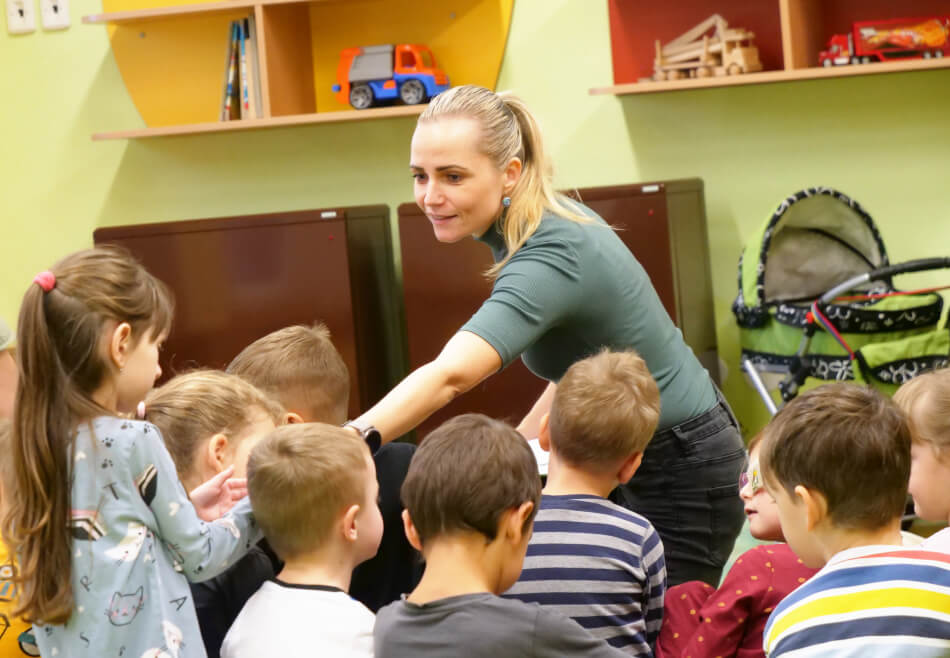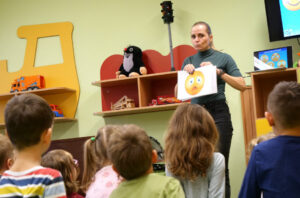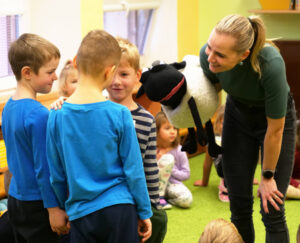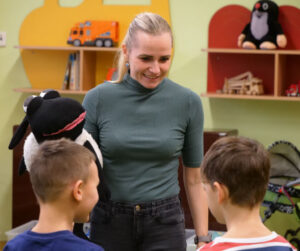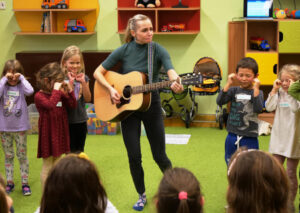Healthy Youth program in the kindergarten – even for the preschoolers – is nothing usual. But Radka is not doing it for the first time, which is obvious at the first sight. It’s not easy to capture the attention of twenty-five lively children. Radka managed to do it for an incredible hour and a half. How did it happen
First, the pupils were given a name tag, which allowed Radka to be more personal with them and to call out to them as they are used to.
She then stuck a smiley face with a different mood in each corner of the room and invited each of the children stand next to the smiley face that describes their mood. They spent some time discussing why they were in that mood and what influenced it.
Then Berta the puppet came on stage. In Radka’s hands, Berta talks to the children about why someone might be sad and if there is anything that can be done about sadness.
And since we agree together that it can, a game of “un-making-sadness” follows. The children stand in a circle and one comes to the other and delivers him from sadness with various gestures, movements and kind words. The one who is freed goes to the next one and the next one until all are “un-saddened”.
Thematically, this part culminates in the expression of joy in a common song, which Radka teaches the children with a guitar in her hands. The children go wild and jump at the song, so that when it is over they are ready to concentrate on the other part of the program.
It runs from the theme of sadness to the theme of joy. This part could boldly be called bullying prevention. The children divide joy into “good” and “bad”. They use examples to tell themselves that the good is the one that does not hurt anyone and the bad is the one that – to put it simply – is gleeful. The word bullying does not come to mind but the context makes it clear how important it is for good relationships to be able to distinguish between these two kinds joys.
The puppet Berta comes on stage again and this time she deals with the topic of quarrels and how to solve them. This is followed by a joint solution to the problem of how to deal with your anger and how to get rid of it. I think this is a very natural way to teach children from kindergarten onwards to get along well and not to hurt each other.
The theme of fear and what to do with it comes up in various playful forms. Radka demonstrates everything with the help of various pictures that make it easier for children to understand everything they are talking about.
I am really surprised how long the children are able to concentrate and have fun. This is mainly due to Radka’s spontaneous communication with the children as well as the illustrations of concrete situations and the complementary games that help to grasp the topics better and more playfully.
As Radka also leads programs at the first level of primary schools, she will surely meet these children again. I believe that after this unusual experience, they will know who they are dealing with and will be ready to open up if there are problems. Radka’s heart is already ready and open for them.
Martin Stavjanik, the Authorized Supervisor of the HY Program workers

